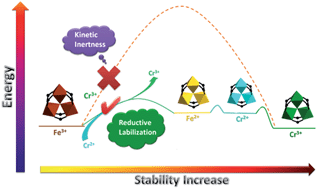The preparation of an ultrastable mesoporous Cr(iii)-MOF via reductive labilization†
Abstract
Kinetic labilization of the Fe(III)–O coordination bond in a mesoporous metal–organic framework, PCN-333-Fe(III), is realized by the reduction of Fe(III) by Cr(II). The Fe(II)–Cr(II) metathesis is thus completely achieved followed by this reductive labilization process that generates PCN-333-Cr(III). The kinetic inertness of Cr(III) provides PCN-333-Cr(III) with enhanced chemical stability as well as a broader range of applications compared to those of PCN-333-Fe(III). For instance, alkylamine incorporated PCN-333-Cr(III) demonstrated significant carbon dioxide uptake while PCN-333-Fe(III) lost its crystallinity after alkylamine treatment.



 Please wait while we load your content...
Please wait while we load your content...